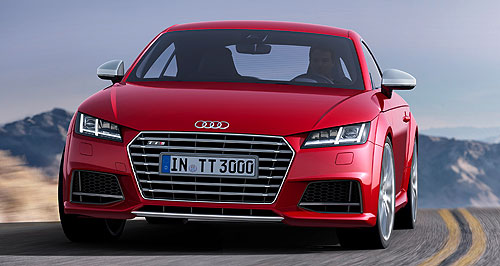Future models - Audi - TTGeneva show: Audi’s new TT emergesLight industry: The new-for-2015 third-generation Audi TT features styling cues that hark back to the original version of the late 1990s, although the harder edge to its front end in particular is unmistakable. Audi looks back to the original, and well into the future, for its new-generation TT4 Mar 2014 By BARRY PARK AUDI has unveiled its hugely anticipated third-generation TT coupe at the Geneva motor show, revealing a highly advanced and more powerful sportscar with a harder edge to its styling that is nonetheless strongly reminiscent of the 1998 original. In recreating the TT, which is due on sale in Australia early next year, Audi’s engineers have shed about 50 kilograms of weight compared with the current model and have shifted from the aluminium-fronted, steel-backed coupe that helped give the car an almost even weight balance between the front and rear wheels. This is on top of an 80kg weight loss for the second-generation model — a standout achievement in an era where many other cars were adding bloat. While the new TT still uses a mix of aluminium and steel, the entire chassis is now made from steel, as is part of the passenger cell where lighter, high-tensile metal helps to cut weight without any loss in rigidity. At 4180mm, the new TT is the same length as the model it replaces, but Audi has lengthened the wheelbase to give the sportscar more straight-line stability. While the wheels now sit 37mm further apart at 2505mm, the TT’s 1832mm width and 1353mm height mirror that of the current model. Some will consider turning back to the first TT for this third generation a retrograde step, but Audi is unrepentant and emphasises the fact that it has returned to many of its original styling themes “and placed them in a new context that is as dynamic as it is diverse”. The squared-off guards and cab-rearward profile that once defined the TT are back, along with detail elements such as the rear guard-mounted fuel cap studded with hex-key bolts. But there are modern themes, too, including the aggressive e-tron-style grille, flat Xenon-plus headlights and a front airdam that borrows heavily from the TT’s supercar sibling, the R8. A rear spoiler that helps with high-speed stability automatically pops up from the hatch lid at speeds above 120km/h. The big note, though, is the performance-oriented TTS, which will once again use a 2.0-litre turbocharged four-cylinder engine. However, instead of producing just 200kW of power sent to all four wheels, the new engine steps performance up to 228kW. Combined with 380Nm of torque available from as low as 1800rpm, the performance is enough to rocket the TTS from 0-100km/h in 4.7 seconds, and all the way to an electronically governed top speed of 250km/h. By comparison, the front-driving entry-level 2.0-litre diesel engine will shuffle the TT to the same speed in 7.2 seconds. A manual gearbox is standard on the European specification list, while controllable flaps in the exhaust system add more voice to the engine note. Buyers who opt for a six-speed dual-clutch automatic transmission will also gain a launch control function to optimise the TTS’s performance from a standing start. Audi says it has also improved the rear axle-mounted quattro all-wheel-drive system fitted to the TT, sending more drive much earlier to the rear wheels in the sportier ‘dynamic’ mode. Turbocharged four-cylinder engine choices, not all necessarily in line for Australia, range from the entry-level 2.0 TDI’s 135kW/380Nm, which will use only 4.2L/100km on the European cycle and produce what Audi says is a record low (for a sportscar) 110g/km of carbon dioxide, and the 2.0 TFSI producing 169kW/370Nm. In stark contrast to the exterior, the TT’s interior looks into the future and features a 12.3-inch digital dashboard instead of analogue dials – Audi calls it a “digital cockpit” – that rings the speedo and tacho in vital information, or shows the infotainment system as a priority. On models fitted with a sports button, the digital dash will replace the instruments with a large tacho once the more dynamic mode is selected. Other features include a much cleaner look to the interior, a smaller centre to the steering wheel thanks to a smaller airbag offering the same level of driver protection, and climate-control air-conditioning dials set into the trio of jetfighter exhaust-style air vents built into the centre of the dash. The TT also uses a similar centre console-mounted dial and buttons to control the multimedia interface, which will offer handwriting recognition in better-equipped models. Standard equipment likely to arrive with the TT in Australia includes halogen headlights and an electric parking brake. The front seats are 5kg lighter than the ones they replace, and sit lower in the TT than before. Options are likely to include a 12-speaker Bang & Olufsen sound system with door-mounted speakers that glow to the beat of the music playing, a wireless internet hotspot that piggybacks off a smartphone, a blind-spot warning system, lane-keeping assistant and even a self-parking function that will steer the TT into a tight space.  Read more20th of February 2014  Geneva show: Audi teases TTSketches indicate Audi will play it safe with evolutionary new-gen TT coupe styling13th of February 2014  Geneva show: Audi warms up new TTAudi's third-gen TT on the cards for Geneva splash, along with topless A3 and S1TT pricing
Motor industry news |
Click to shareAudi modelsTT pricing
Motor industry news |




























Facebook Twitter Instagram